Timothy Riesterer's Blog, page 20
September 21, 2016
The Enablement Supply Chain & the Path to Readiness
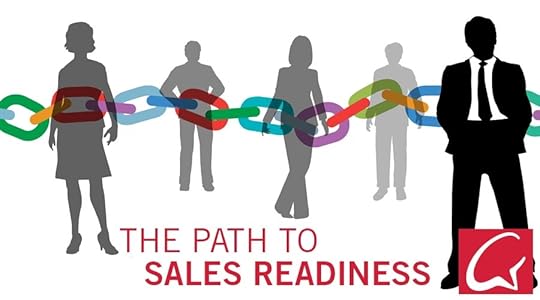
GE Digital was founded on the premise that it’s time to move from selling things to selling outcomes—and they knew that getting there would require a transformation in their sales enablement supply chain. Barbara Mazziotti, senior global sales enablement leader at GE, said that previously, the company’s sales enablement efforts relied on intense roadshows and product management-led customer stories. Not anymore. The company now leverages e-learning solutions and consistent sales-led stories.
A big part of transforming their path to sales readiness depended on developing a differentiated message and a distinct point of view they could take to the market. GE Digital’s Brandon Perkins called the message development component a structured process, noting that one of the most important factors for having a great cross-functional workshop is making sure you have a well-balanced cross-section of people in the room. That means having a good combination of technical people, commercial people and leadership.
Then, taking the message from the ideation phase to your sales force involves four steps:
Pre-planning – Set the stage by selecting the cross-functional team and having a framework call with Corporate Visions strategists.
Build the story – This is the two-day workshop itself where the differentiated message and points of view come together. Be sure to clear your calendars, commit to the exercise, and assign a “decider” who can resolve impasses if they occur
Refine the story – Stay the course during the post-workshop debrief, where the editorial process gets underway with your internal review team and Corporate Visions.
Packaging – Don’t celebrate yet! It’s time to cement final deliverables and develop a sales enablement rollout plan.
Some final pointers to make the path to sales readiness as smooth as possible: Announce expectations of mastery for all sellers, and have them watch an internal expert deliver the whiteboard point of view live. For further education and reinforcement, have reps watch e-learning coaching videos, practice in groups at kickoff, and have a stand-and-deliver contest.
#CTW16 Recap: The Enablement Supply Chain & the Path to Readiness
GE Digital was founded on the premise that it’s time to move from selling things to selling outcomes—and they knew that getting there would require a transformation in their sales enablement supply chain. Barbara Mazziotti, senior global sales enablement leader at GE, said that previously, the company’s sales enablement efforts relied on intense roadshows and product management-led customer stories. Not anymore. The company now leverages e-learning solutions and consistent sales-led stories.
A big part of transforming their path to sales readiness depended on developing a differentiated message and a distinct point of view they could take to the market. GE Digital’s Brandon Perkins called the message development component a structured process, noting that one of the most important factors for having a great cross-functional workshop is making sure you have a well-balanced cross-section of people in the room. That means having a good combination of technical people, commercial people and leadership.
Then, taking the message from the ideation phase to your sales force involves four steps:
Pre-planning – Set the stage by selecting the cross-functional team and having a framework call with Corporate Visions strategists.
Build the story – This is the two-day workshop itself where the differentiated message and points of view come together. Be sure to clear your calendars, commit to the exercise, and assign a “decider” who can resolve impasses if they occur
Refine the story – Stay the course during the post-workshop debrief, where the editorial process gets underway with your internal review team and Corporate Visions.
Packaging – Don’t celebrate yet! It’s time to cement final deliverables and develop a sales enablement rollout plan.
Some final pointers to make the path to sales readiness as smooth as possible: Announce expectations of mastery for all sellers, and have them watch an internal expert deliver the whiteboard point of view live. For further education and reinforcement, have reps watch e-learning coaching videos, practice in groups at kickoff, and have a stand-and-deliver contest.
September 20, 2016
#CTW16 Recap: Driving Behavior Change in a World of Unreliable Managers
Sixty six days—that’s how long it takes to build better habits in a sales force, according to United Rentals’ Shelley Robins, citing a manager impact study. This fundamental training challenge is not necessarily an issue because sales managers are unreliable; it’s an issue because driving adoption in the field is an imperative.
Often times, as Robins noted, knowing how well you’re doing here comes down to answering two questions: How much are the skills being used, and how much do they help? Adoption doesn’t happen by accident, and there are five leading indicators that Robins and Tom Jones, also of United Rentals, keep in mind when assessing how they’re doing:
Behavior changes
Value articulation skills
Negotiation skills
Branch manager reinforcement efforts
Coaching and reinforcement
Here are a two tips offered by Robins and Jones for staying strong across some of these crucial adoption indictors:
Small improvements = wins. Focus on certain topics of training at a time. For example, drill down on key negotiations skills to keep your team sharp on their skills, such as setting high targets or expanding the range of reason.
Provide a proof of mastery step for certification, giving managers skills check lists they can use to ensure reps are fluent across the most important selling skills and concepts.
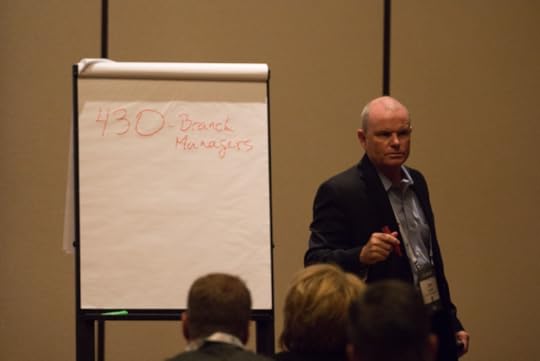
United Rentals’ Tom Jones presents in the Transformation track at #CTW16.
Raising the Bar at CUNA Mutual
Terry Cogburn, director, organization capability at CUNA Mutual, had a simple question she wanted to answer: What if reps could apply more of the key selling techniques that our top performers were using regularly?
Three years after asking that question, CUNA was driving consistent results by striving toward that goal, to the tune of 25 percent larger pipelines, 20 percent larger deals, and a 23 percent increase in goal attainment.
A crucial aspect of this behavior change transformation? In the rollout, CUNA Mutual trained sales managers first, because they had to find a way to help managers diagnose and coach. While deal coaching was a strength of many sales managers, skills coaching was not something many were comfortable with. Another key element of the process, Cogburn said, was establishing a coaching academy to build reinforcement and make sure the behavior changes they’d worked hard to realize remained sticky in the long run.
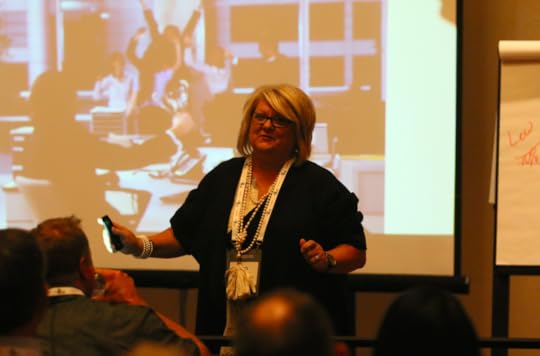
CUNA Mutual’s Terry Cogburn
Driving Behavior Change in a World of Unreliable Managers

Sixty six days—that’s how long it takes to build better habits in a sales force, according to United Rentals’ Shelley Robins, citing a manager impact study. This fundamental training challenge is not necessarily an issue because sales managers are unreliable; it’s an issue because driving adoption in the field is an imperative.
Often times, as Robins noted, knowing how well you’re doing here comes down to answering two questions: How much are the skills being used, and how much do they help? Adoption doesn’t happen by accident, and there are five leading indicators that Robins and Tom Jones, also of United Rentals, keep in mind when assessing how they’re doing:
Behavior changes
Value articulation skills
Negotiation skills
Branch manager reinforcement efforts
Coaching and reinforcement
Here are a two tips offered by Robins and Jones for staying strong across some of these crucial adoption indictors:
Small improvements = wins. Focus on certain topics of training at a time. For example, drill down on key negotiations skills to keep your team sharp on their skills, such as setting high targets or expanding the range of reason.
Provide a proof of mastery step for certification, giving managers skills check lists they can use to ensure reps are fluent across the most important selling skills and concepts.
#CTW16 Recap: Customizing Your Corporate Visions IP
You’ve built a message with a distinct point of view and you’ve trained your salespeople to make an impact in meetings. But all your disruptive messaging and situational fluency won’t do much good if you can’t differentiate yourself before your reps ever meet a prospect in person. If you can’t, you might never get the meeting you covet.
Thankfully, as Thomson Reuters’ Kurt Gruebling explained in this session, you can take advantage of Power Messaging techniques to rise above the noise and excel in the “meeting before the meeting” too. In other words, you don’t have to wait until you get a meeting to use Power Messaging skills; you can use them to make that meeting happen.
A big part of that, he says, is having the ability to point prospects and customers to underappreciated problems, risks or trends that are negatively impacting their business—in other words, messaging to buyers’ “unconsidered needs.”
Gruebling identified four key elements of great appointment setting—all based on Power Messaging techniques:
Open by sharing a compelling insight that tells prospects about a problem or missed opportunity they don’t yet know about, but that could be setting them up for business difficulties sooner rather than later.
Speak to the challenges your insight has exposed, and show prospects how their current situation is unsafe and could leave them vulnerable going forward.
Resolve the risks you’ve identified by pointing to a new, safe alternative that can bring them from the unsafe of their status quo to a “new safe” with your solutions.
Finally, ask for an appointment! It sounds simple, but making your intentions clear can increase the likelihood your prospects will take action on the story you’ve told them.
Finally, Gruebling noted that it’s not the words of a particular insight itself that makes your story resonate. Rather, it’s the broader story you embed those words within that will make your messaging compelling and actionable.
September 9, 2016
We Asked Why #CTW16 is Essential for Attendees. They Answered!
Why is it essential that you attend Conversations That Win 2016?
We asked, and you responded—in droves. What started out as a fun way to promote one of our keynotes at #CTW16 ended up as an illuminating, crowd-sourced reminder about why great messaging matters, and how it can transform companies, careers and lives.
Check out some of the top responses below!
September 1, 2016
Do Your Insights Excite or Incite?
Selling with insights is no longer optional—it’s mandatory for marketers and salespeople hoping to tell an actionable story. But new research shows that driving action isn’t just about challenging your prospect’s status quo with surprising information and data points—the traditional insights-based approach. That’s a start. But to create urgency that’s actionable, your insights need to go beyond risk and show how you’re uniquely qualified to resolve the risks you’ve identified.
This is the difference between insights that excite versus insights that incite. The former message gets consumed and forgotten about. The latter drives buying decisions, creating the urgency to change and then showing how that change is possible…and better than what your prospect is doing today.
Risk and Resolution
A story that pairs risk and resolution seems like it’s moving in the direction of actionable messaging. But how does it play out in practice? 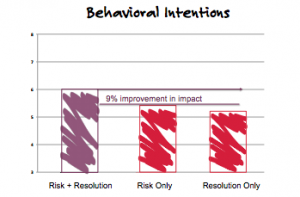 Corporate Visions teamed up with Dr. Zakary Tormala, a social psychologist with expertise in messaging and social influence, to find out. The study, conducted online, included more than 320 participants, evenly split by gender. Specifically, it aimed to test the messaging effectiveness of two different types of insights-based messages, focusing in particular on the behavioral and emotional impact of each message type:
Corporate Visions teamed up with Dr. Zakary Tormala, a social psychologist with expertise in messaging and social influence, to find out. The study, conducted online, included more than 320 participants, evenly split by gender. Specifically, it aimed to test the messaging effectiveness of two different types of insights-based messages, focusing in particular on the behavioral and emotional impact of each message type:
Risk-only insights designed to make prospects feel unsafe in their status quo by introducing surprising new industry data points.
Risk + Resolution insights, similarly designed to make the status quo feel unsafe, but also introducing solutions that resolve the prospect to a “new safe” in the same message.
The study revealed that you can gain a statistically significant advantage in both behavioral and emotional impact if your message includes risk and resolution, versus risk alone.
Want to learn more about the persuasive impact you can have with a message structured to create risk and resolution? Check out our research brief to learn more about the study.
Putting an “Unconsidered Needs” Message to the Test
The idea of linking a prospects’ unconsidered needs to your unexpected strengths sounds like it has potential as a message differentiator. But an interesting theory doesn’t always flower into an actionable practice, and we felt the concept deserved a closer look…so that’s what we gave it.
Corporate Visions teamed up with Dr. Zakary Tormala, a social psychologist with expertise in messaging and persuasion, to put the “unconsidered needs” approach to the test. Specifically, we wanted to test its messaging effectiveness against more traditional approaches, such as responding to the stated or known needs of your prospects, as well as the typical “value-added” approach many salespeople use to create differentiation.
For the study, we enlisted 400 individuals to take part in an online experiment. We asked participants to imagine they ran a large company and were considering partnering with a financial lending firm to explore growth opportunities in the face of an economic downturn, which was causing slow sales cycles and cash flow challenges. All participants were instructed to imagine they were seeking a $10 million line of credit and were told they would view a pitch from a particular lender who’d like to partner with them.
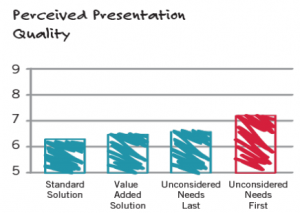 What participants didn’t know is that they were randomly assigned to one of four different messaging pitches or conditions—a standard pitch, a value-added pitch, and two pitches that presented an unconsidered need (one at the beginning of the pitch, the other at the end).
What participants didn’t know is that they were randomly assigned to one of four different messaging pitches or conditions—a standard pitch, a value-added pitch, and two pitches that presented an unconsidered need (one at the beginning of the pitch, the other at the end).
So which pitch won in the areas of presentation quality, perceived uniqueness, and in critical attitude and choice measures? It turns out that a pitch that presents an “unconsidered need” first gives sellers a statistically significant advantage in the areas above, compared to traditional approaches…and the margin of difference wasn’t even close.
The study found that leading with an unconsidered need outperformed the other approaches by:
+11 percent in terms of presentation quality.
A whopping +41 percent in terms of presentation uniqueness.
+10 percent in attitude and choice measures, which assessed how much the message enhanced attitudes toward the lending partner and boosted purchase intent.
According to Tormala, the results are consistent with uncertainty research, which shows that highlighting unconsidered needs is unexpected and promotes uncertainty, which in turn accelerates decision processing.
Want to see an example of a pitch that connects unconsidered needs to unconsidered strengths, and learn more about the results of the study? Check out the research brief.
August 31, 2016
Emotions Make Significant Difference in Executive Decision-Making, New Study Finds
The way your message is worded can change an executive’s mind about choosing a risky option even when the “math” is the same
PLEASANTON, Calif., Aug. 16, 2016 /PRNewswire/ — Corporate Visions, Inc., the leading marketing and sales messaging, content and skills training company, announced results of an experiment showing that executives are more willing to make a risky business decision when the alternative, including the current status quo, is framed in terms of loss instead of gain. In fact, even though the “math” was exactly the same in both options, the words used to present the choices affected executives’ willingness to make a different choice by more than 70 percent.
For the experiment, Corporate Visions contracted with Dr. Zakary Tormala, an expert in persuasion and messaging who created the research and conducted the study. Separately, Tormala is a social psychologist at the Stanford Graduate School of Business.
“This research debunks the long-held and promoted perception that executives are hyper-logical and numbers-oriented in their decision-making, and that marketers and salespeople need to message exclusively to their sense of reason because of it,” saidTim Riesterer, chief strategy officer at Corporate Visions. “Turns out, executives are just as much influenced by emotions as everyone else, and as this study shows, they’re more willing to take risks if a marketing and sales message is crafted appropriately.”
The research was organized around the concepts of “loss aversion” and “risk-seeking,” which together make up the behavioral economics concept called Prospect Theory, developed by social psychologists Daniel Kahneman and Amos Tversky. In sum, Prospect Theory holds that humans are two-to-three times more likely to make a decision or seek a risk to avoid a loss than to attain a gain.
The online experiment involved 113 participants, all executives from a range of industries, including oil, software, finance, aerospace, etc., and occupying a diverse set of high-level roles in their companies (e.g. president, VP, CEO, CFO, etc.). The participants’ decision-making behaviors were tested in a business scenario, as well as in two personal decision-making scenarios. For the business scenario, half of participants were placed in a “gain frame” scenario, where the choices were described in terms of how many facilities and jobs would be saved. Conversely, the other half were placed in a “loss frame” scenario, where the facilities and jobs in each choice were described in terms of how many would be lost.
While all the options were mathematically identical in both the “gain” and “loss” frame conditions, the study revealed thatparticipants in the loss frame were more willing to make the risky business decision by more than 70 percent. The same held true for both personal decision-making scenarios where the influence of loss aversion on the executive participants was shown to be similarly pronounced.
“These findings show that you’ll significantly improve your chances of persuading executives to change or take a risk – which your solution typically represents – by positioning the alternative as a loss condition,” added Conrad Smith, vice president of Consulting for Corporate Visions and co-developer of the study.
For an in-depth look at this research and all the scenarios it tested, please consult this research brief.
August 10, 2016
Are Your Reps a Selling “Triple Threat?”
By Tim Riesterer, chief strategy officer, Corporate Visions
 In show business, the classic “triple threat” is a multi-talented performer who can act, dance and sing at world-class levels. In sales, there’s also a set of performance skills your salespeople need to master to become a selling triple threat—and they have to do with three “Ps”—pipeline, proposals and profits.
In show business, the classic “triple threat” is a multi-talented performer who can act, dance and sing at world-class levels. In sales, there’s also a set of performance skills your salespeople need to master to become a selling triple threat—and they have to do with three “Ps”—pipeline, proposals and profits.
But let’s rewind a second to my previous post and frame these skills areas within the context of virtual training, which 65 percent of companies plan to increase investment in.
As our survey revealed, the main challenge of modern training is two-fold: Training managers balk at investing time in the training format they believe to be most effective (instructor-led). And, they’re not sure how to keep reps in the field without compromising the quality of training.
So what’s needed?
Here are three things companies need to overcome these critical training challenges:
1. Competency Model-Driven Training Curriculum – According to Sirius Decisions, 70-80 percent of companies do not followed a competency-based training model. That means there’s no standard set of skills that salespeople need to master, and no agreement about what level of proficiency they must demonstrate.
What’s a reasonable roadmap for developing a competency-based training program? One idea is to build a competency model around the three “Triple Threat” areas reps must master across the buying cycle to drive success and growth:
a) Pipeline – Provide training, practice and coaching on the ability to disrupt the status quo, convince a prospect or customer of the need to change, and then effectively differentiate from competitive alternatives to create more qualified opportunities.
b) Proposals – Provide skills development and tools to improve the ability of reps to connect external factors and key customer initiatives to your solution, and then build a meaningful business case that communicates value and passes muster with executives.
c) Profits – Provide concepts and techniques to make sure your reps don’t let value leak and margins suffer as the deal makes its way through the process and you confront the inevitable pricing pressures and run the procurement gauntlet.
By ensuring reps are being trained, coached, measured and certified on these skills, you will improve the relevance of your curriculum relative to sales’ key performance indicators.
2. Custom Learning Paths based on Performance Indicators – With a competency model in place, you can now replace your outdated “arbitrary learning paths” with custom learning paths designed to up-skill salespeople in the areas they actually need, versus relying on unreliable manager opinions or generic role- or tenure- based development plans.
Helping to make this easier is the fact that data is available from several sources which can help determine each rep’s specific area of training needs. For example, you can look to your CRM system to find which reps are struggling to create pipeline sufficient to meet their quota; you can see which reps tend to have deals and proposals get stuck in the middle of pipeline because they struggle to get executive-level buy-in; you can look at deal data to see which reps are the most lax when it comes to discounting and pricing.
Through these performance indicators you can begin to assign the appropriate training to your reps, helping you address the areas of greatest concern. In addition, you can consider behavioral outcome type assessments that help determine the skills gaps associated with each of the competencies in your model. Well-written surveys that include benchmark data for comparison to low and high performers can help you prioritize which reps need help in which areas.
3. Flexible Learning Modalities – Competency models and custom learning paths won’t help your reps become Triple Threats unless you can get the right training to the right reps at the right time. As the survey detailed in my previous post discovered, time is the biggest enemy of a great training program. In traditional classroom learning, reps are often waiting to attend a scheduled class in a city near them that may be months out from when you have determined their need, only to have that date come and the rep’s manager decide they can’t leave the field (or, something like a travel freeze could also keep them grounded in their home office).
Imagine being able to “push” virtual, modular content to each of your reps, as soon as you determine the gaps and deficiencies in their performance? The idea of just-in-time, situational learning is a reality with modular online training options that can intercede immediately when an acute performance challenged is identified, creating a custom learning path.
Classroom training may still be regarded as the standard when it comes to creating behavior changes in the field. But, valuable as they are, they’ll have zero impact if you can’t get reps into the classroom when they need it.
That’s why companies need virtual training formats that strive to replicate the training rigor of a classroom setting, providing competency-based training, custom learning paths and situational learning modalities that improve reps’ performance without removing them from the field.
To learn more about training reps to the skills they need to master to control the buying cycle, check out this infographic.
Timothy Riesterer's Blog
- Timothy Riesterer's profile
- 3 followers



